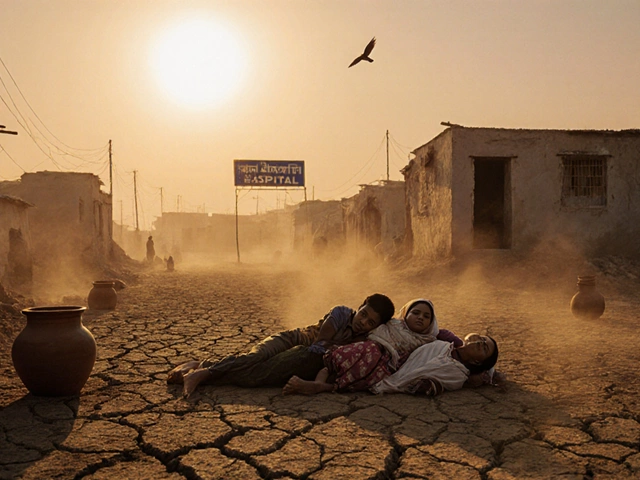In the world of environmental protection, several charitable organizations have carved out a place of prominence due to their relentless efforts and impactful projects. These organizations act as warriors against climate change, defenders of ecosystems, and champions for sustainable practices.
One name consistently emerges as a beacon of hope in these endeavors. We'll explore how this charity has influenced policy changes, empowered communities, and inspired global participation in saving our planet. Join us as we highlight their journey, achievements, and how you can play a part in their mission.
As environmental concerns climb to the top of the global agenda, understanding the role and success of these charities is more critical than ever. Let's dive into the stories and strategies that make them leaders in their field.
- The Pioneers of Environmental Charities
- Impact on Global Environmental Issues
- Innovative Initiatives and Projects
- How to Support Environmental Causes
The Pioneers of Environmental Charities
In the vibrant tapestry of ecological conservation, a few environmental charities stand as luminous threads. Their journey into this noble realm often begins with a singular vision or pivotal moment that sparks a global movement. The World Wildlife Fund (WWF), established in 1961, is among the most influential. Driven by the guiding principle of preserving the world's biodiversity, WWF has grown to become an emblem of dedication and success in environmental conservation. It's fascinating to realize that WWF's inception was not just an idea but a response to an overwhelming and immediate need to address pressing environmental issues that were being overlooked at the time.
Heading into the 1970s, Greenpeace emerged with a rousing and decidedly bold approach, challenging practices that endangered the planet. With its roots in Canada, Greenpeace became synonymous with activism, applying direct action techniques to halt nuclear testing and whaling. Their daring efforts caught the public's eye and spearheaded a new era of environmental advocacy. Today, the organization remains steadfast in tackling climate change and promoting sustainable development. As Paul Watson, one of Greenpeace's co-founders, said, "It is not about what you do, but what you accomplish... and we were young enough to believe we could accomplish... anything."
The Sierra Club, founded in 1892, is one of the most enduring environmental charities in the United States, pivotal in establishing the modern environmental movement. With John Muir at the helm, this organization has been instrumental in the establishment of national parks and advocating for the preservation of wilderness corridors. The Sierra Club's commitment to engaging citizens through educational programs and government advocacy has proven that grassroots activism can effect real change. Their story reminds us that little steps taken collectively can have a monumental impact on policy and conservation.
Another critical player in the field is The Nature Conservancy, originally founded as the Ecologists Union in 1946. With an innovative approach that marries economics and conservation, it has protected over 125 million acres worldwide. By purchasing and managing lands vulnerable to development, The Nature Conservancy has demonstrated that strategic creativity can coexist with ecological integrity. Their model of using science-backed strategies has painted a roadmap for others to follow, showing how conservation efforts can be both effective and practical.
It's essential to recognize charitable organizations like these not only for their past achievements but also for their potential to influence future generations. These famous charities have laid the groundwork for a collaborative global effort towards environmental sustainability. They serve as inspiration, encouraging individuals to engage in environmental groups and to support causes that resonate with them. These pioneers remind us of the power of visionaries who dare to tackle global challenges head-on, transforming ordinary ideas into extraordinary results.

Impact on Global Environmental Issues
The influence of renowned environmental charities on global challenges is profound, revealing a multi-layered tapestry of dedication and innovation. These organizations do not merely react; they shape the conversation, often leading the charge against climate change with actionable strategies. The key to their success lies in a combination of science-backed initiatives and community involvement, ensuring that their efforts resonate across diverse demographics. By aligning their projects with scientific research, these charities maximize their impact, offering tangible results that spark both policy changes and public awareness.
One such influential charity, often hailed as a pioneer, has effectively addressed carbon emissions reduction. By promoting reforestation projects worldwide, they have restored millions of hectares of mangroves and rainforests, buffering the impacts of climate disturbances. Their work extends beyond planting trees; it includes educating local communities on sustainable practices, effectively turning them into environmental stewards. This comprehensive approach ensures that efforts are sustained long-term, vastly amplifying their impact.
A particularly innovative program involves the utilization of satellite technology to monitor deforestation in real-time. This cutting-edge application allows quick identification and response to illegal activities, preserving vital ecosystems. Furthermore, it showcases the synergy between technology and environmentalism, encouraging other environmental groups to adopt similar models. A spokesman for the organization once said,
"Harnessing technology in our fight for the planet amplifies our capabilities, and this partnership of man and machine is crucial for the future we envision."
The charity's initiatives have far-reaching implications, influencing not only the environment but also socio-economic conditions. By employing local populations in conservation projects, these organizations provide much-needed economic support, creating jobs that empower communities. Moreover, these efforts help to instill a sense of ownership and stewardship towards natural resources among the people who are most affected by environmental changes. These multifaceted benefits highlight why such a charity continues to hold an influential place on the global stage.
Data and Results
| Year | Hectares Reforested | Carbon Reduction (Tonnes) |
|---|---|---|
| 2020 | 500,000 | 1,200,000 |
| 2021 | 750,000 | 1,800,000 |
| 2022 | 1,000,000 | 2,500,000 |
The table above illustrates the significant achievements of this renowned charity over the past few years. Such data underscore the practical impact these projects have and serve as a motivational blueprint for emerging environmental groups. With their continued efforts, the positive influence they exert will only grow, painting a hopeful future for global environmental conservation.

Innovative Initiatives and Projects
When it comes to groundbreaking initiatives, the most famous environmental charity stands out with its dynamic projects that are changing the face of sustainability worldwide. One of their hallmark programs involves the restoration and preservation of critical biodiversity hotspots. They work hand in hand with local communities and governments to ensure that these vital areas are not only protected but thrive. By introducing sustainable farming techniques and offering education about native species, they've been able to rejuvenate many ecosystems previously thought beyond repair.
Another standout initiative is their comprehensive clean water project, which tackles pollution in some of the world's most polluted rivers. They’ve utilized innovative filtration technology to clean these waters, directly improving the health conditions of millions living nearby. This has significantly reduced waterborne diseases and has fostered a better quality of life for people in these areas. A notable aspect of this project is its educational component, where locals are trained to maintain and operate these filtration systems, ensuring sustainability for years to come.
The charity’s dedication to renewable energy also deserves mention. They've launched solar power projects in remote communities that previously relied on environmentally destructive energy sources. Through these projects, not only has the carbon footprint of these areas been drastically reduced, but they have also created jobs and boosted local economies. Former Vice President Al Gore praised the charity in a keynote speech, stating,
"Their relentless pursuit of sustainable energy solutions sets a benchmark for others in the environmental sector."The charity's influence is undeniable, capturing attention and support from influential figures globally.
Furthermore, their urban greenery project brings nature back into cities, transforming urban jungles into green oases. By planting thousands of trees and creating rooftop gardens, they are not only beautifying cityscapes but also improving air quality and providing habitats for city-dwelling wildlife. These projects serve as a brilliant reminder of what can be achieved when nature and urban life coexist harmoniously. Community involvement is at the heart of this initiative, with tree-planting events and educational workshops fostering local participation and enthusiasm.
In the educational realm, the charity has also developed an environmental curriculum targeted at schools worldwide, aiming to instill a strong ecological ethic in the next generation. The emphasis is on critical thinking and problem-solving skills related to environmental issues, preparing students to become proactive stewards of the planet. Through interactive workshops and collaborations with educational institutions, they have effectively reached a vast number of young minds, inspiring change from the ground up.
This comprehensive approach, combining conservation, innovation, education, and community involvement, embodies what makes this organization a stalwart in the realm of environmental charities. Their projects not only address immediate concerns but are meticulously designed to have long-lasting impacts, ensuring a sustainable future. With such admirable efforts, they set an example of how innovative thinking and collective action can drive meaningful progress against environmental challenges.

How to Support Environmental Causes
Supporting environmental causes can seem like a daunting task, but there are numerous ways that individuals can make meaningful contributions towards the betterment of our planet. One of the simplest methods is to stay informed about environmental issues. Understanding what's happening in the world allows you to make informed choices and advocate effectively. Whether through books, documentaries, or reputable websites, knowledge is a potent tool in the fight against environmental degradation. In this digital age, subscribing to newsletters from renowned environmental charities can keep you up-to-date with initiatives you can support, and changes you can enact in your own community.
Another powerful way to contribute is through financial donations. Even small amounts pooled together can fund large-scale projects aimed at sustainable development and conservation. Many famous charities offer options for recurring donations, providing a steady stream of support. Beyond monetary donations, volunteering your time and skills is invaluable. Charities often need hands-on assistance for events, educational outreach, and even social media advocacy. Volunteering not only helps the charity but provides you with firsthand experience in the field, which can be incredibly rewarding.
The impact of your carbon footprint is another critical area where you can contribute. Simple changes in daily habits, such as recycling, conserving water, reducing energy consumption, and choosing sustainable products, make a big difference. Promoting these practices within your workplace or community can amplify your contribution significantly. Some environmental groups even provide resources and workshops aimed at teaching these sustainable practices. Additionally, raising awareness and educating others, whether through social media, community events, or simply word of mouth, helps to grow a culture that prioritizes the environment.
Jane Goodall once remarked, "What you do makes a difference, and you have to decide what kind of difference you want to make." This notion encapsulates the spirit behind supporting environmental charities. It's the collective actions of conscientious individuals that drive the significant changes we see today.Supporting legislation that favors environmental protection is another vital aspect. Writing to your local representatives, signing petitions, and participating in rallies can influence policymaking at local and international levels. Stay connected with organizations that monitor environmental policies and provide templates or guidance for communicating with legislative bodies. This level of involvement demonstrates a commitment not only as a financial supporter but as an active advocate for the environment.
Lastly, consider supporting businesses that align with sustainable practices. Your purchasing choices can encourage companies to adopt more environmentally friendly processes. Keeping an eye out for certifications like Fair Trade, Organic, and those indicating recycled content can guide you towards making better choices. Engaging with these businesses' community programs not only bolsters their efforts but provides an additional avenue for involvement in environmental causes. By leveraging knowledge, financial resources, and daily practices, everyone can play a pivotal role in the global effort to protect our environment.





